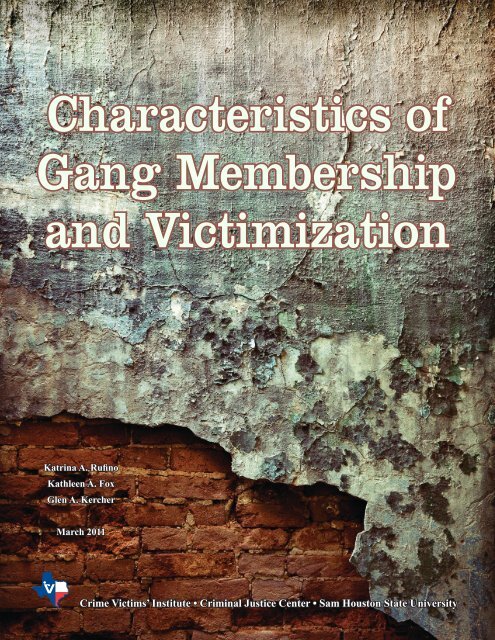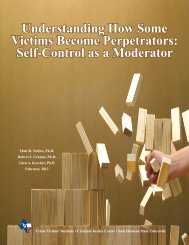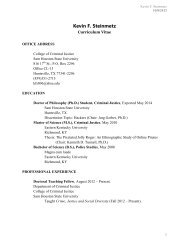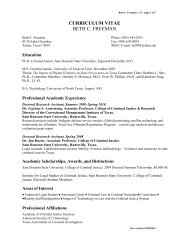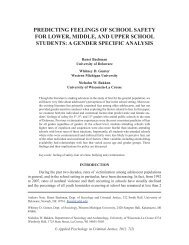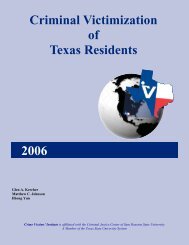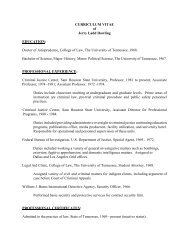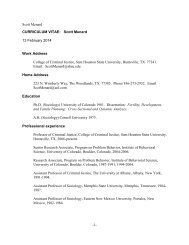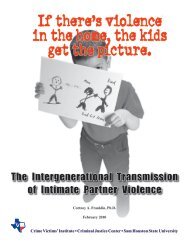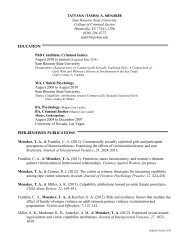Characteristics of Gang Membership and Victimization
Characteristics of Gang Membership and Victimization
Characteristics of Gang Membership and Victimization
Create successful ePaper yourself
Turn your PDF publications into a flip-book with our unique Google optimized e-Paper software.
<strong>Characteristics</strong> <strong>of</strong><br />
<strong>Gang</strong> <strong>Membership</strong><br />
<strong>and</strong> <strong>Victimization</strong><br />
Katrina A. Rufino<br />
Kathleen A. Fox<br />
Glen A. Kercher<br />
March 2011<br />
Crime Victims’ Institute • Criminal Justice Center • Sam Houston State University
…from the Director<br />
This report addresses the relationship <strong>of</strong> victimization between gang members <strong>and</strong> those<br />
not affiliated with gangs. In addition, comparisons were made between gang members who<br />
were victimized <strong>and</strong> those who were not. An attempt is made to identify contextual factors<br />
that are <strong>of</strong>ten in place when victimization occurs. These results stem from interviews with<br />
incarcerated gang members <strong>and</strong> non-gang affiliated inmates. It is our hope that this report will<br />
help to inform the public about the risks associated with gang membership <strong>and</strong> the steps that<br />
could be taken to prevent it.<br />
Glen Kercher<br />
Crime Victims’ Institute<br />
Mission Statement<br />
Mission Statement<br />
The mission <strong>of</strong> the Crime Victims’ Institute is to<br />
• conduct research to examine the impact <strong>of</strong> crime on victims <strong>of</strong> all ages in<br />
order to promote a better underst<strong>and</strong>ing <strong>of</strong> victimization<br />
• improve services to victims<br />
• assist victims <strong>of</strong> crime by giving them a voice<br />
• inform victim-related policymaking at the state <strong>and</strong> local levels.
Table <strong>of</strong> Contents<br />
Executive Summary. .........................................................2<br />
<strong>Characteristics</strong> <strong>of</strong> <strong>Gang</strong> <strong>Membership</strong> <strong>and</strong> <strong>Victimization</strong> ..............................3<br />
Method ....................................................................5<br />
Measures ..................................................................5<br />
Results ....................................................................6<br />
Discussion ................................................................14<br />
Endnotes. .................................................................15<br />
Figures <strong>and</strong> Tables<br />
Figure 1. Ethnicity <strong>of</strong> gang <strong>and</strong> non-gang members .................................7<br />
Figure 2. Educational level <strong>of</strong> gang <strong>and</strong> non-gang members. ..........................7<br />
Figure 3. Marital status <strong>of</strong> gang <strong>and</strong> non-gang members. .............................8<br />
Table 1. Descriptive characteristics <strong>of</strong> gang <strong>and</strong> non-gang members ....................8<br />
Figure 4. Theft victimization among gang <strong>and</strong> non-gang members .....................9<br />
Figure 5. Simple assault victimization among gang <strong>and</strong> non-gang members .............10<br />
Figure 6. Aggravated assault victimization among gang <strong>and</strong> non-gang members. .........10<br />
Figure 7. Target <strong>of</strong> drive by victimization among gang <strong>and</strong> non-gang members ..........11<br />
Table 2. Descriptors <strong>of</strong> gang membership ........................................12<br />
Table 3. Descriptors <strong>of</strong> gang member conduct ....................................13
Executive Summary<br />
The relationship between gang membership <strong>and</strong> crime victimization has only<br />
recently begun to be examined. Much remains unknown about the descriptive nature <strong>of</strong><br />
the gang-victimization link, especially among incarcerated populations. The current study<br />
aimed to provide a backdrop to the emerging gang-victimization literature by examining:<br />
(1) characteristics <strong>of</strong> victimization for gang <strong>and</strong> non-gang members, (2) descriptors <strong>of</strong> gang<br />
membership comparing victimized to non-victimized gang members, <strong>and</strong> (3) characteristics<br />
<strong>of</strong> gang membership comparing victimized to non-victimized gang members. A sample <strong>of</strong><br />
both gang <strong>and</strong> non-gang member prison inmates were interviewed <strong>and</strong> answered a series <strong>of</strong><br />
questions regarding involvement in crime <strong>and</strong> experiences with victimization. <strong>Gang</strong> members<br />
answered further questions pertaining to gang membership <strong>and</strong> gang member conduct. Results<br />
indicate that gang members were significantly more likely to be victimized compared to nongang<br />
members <strong>and</strong> gang members were more likely to be alone <strong>and</strong> under the influence <strong>of</strong><br />
substances when victimized. <strong>Characteristics</strong> <strong>of</strong> membership <strong>and</strong> gang member conduct by<br />
victimization status are also presented.<br />
Acknowledgements:<br />
This research was funded by the Crime Victims Institute at Sam Houston State University.<br />
The opinions expressed here are those <strong>of</strong> the authors <strong>and</strong> do not necessarily represent the<br />
position <strong>of</strong> the funding agency or those <strong>of</strong> the participating correctional facilities. The authors<br />
would like to thank the prison administrators <strong>and</strong> inmates who participated in this research.<br />
Disclaimer:<br />
The research contained in this document was coordinated in part by the Texas<br />
Department <strong>of</strong> Criminal Justice Project #582-AR09. The contents <strong>of</strong> this document reflect<br />
the views <strong>of</strong> the author(s) <strong>and</strong> do not necessarily reflect the views or policies <strong>of</strong> the Texas<br />
Department <strong>of</strong> Criminal Justice.
<strong>Characteristics</strong> <strong>of</strong> <strong>Gang</strong> <strong>Membership</strong> <strong>and</strong> <strong>Victimization</strong><br />
Katrina A. Rufino, M.A.<br />
Kathleen A. Fox, Ph.D.<br />
Glen A. Kercher Ph.D.<br />
<strong>Gang</strong>s are beginning to reemerge as an important topic among policy makers <strong>and</strong><br />
researchers 1 , <strong>and</strong> interest in gangs is fast approaching the level observed in the 1980s <strong>and</strong><br />
1990s. At the federal level, the <strong>Gang</strong> Abatement <strong>and</strong> Prevention Act <strong>of</strong> 2009 was reintroduced<br />
(based on the federal bill from 2007 that was passed by the Senate but not the House) <strong>and</strong><br />
recently passed by the Senate. This bill proposes expenditures <strong>of</strong> over one billion dollars to<br />
increase prosecution <strong>and</strong> prevention efforts against gangs. 2 While the relationship between<br />
3,4,5,6,7,8,9,10,11, 12.13,14,15<br />
gang membership <strong>and</strong> involvement in criminal behavior is well-established,<br />
comparatively little is known about the extent to which gang members are victimized. Of the<br />
few studies that focus on the victimization <strong>of</strong> gang members, findings appear to be mixed <strong>and</strong><br />
the extent to which gang members experience victimization remains unclear. Examining the<br />
gang-victimization link is important for gaining a deeper underst<strong>and</strong>ing <strong>of</strong> gang members’ lives<br />
<strong>and</strong> experiences within the gang. Therefore, the current study aims to further investigate the<br />
gang-victimization link by comparing gang-related factors between victimized gang members<br />
<strong>and</strong> non-victimized gang members.<br />
<strong>Gang</strong>s <strong>and</strong> <strong>Victimization</strong><br />
While the relationship between gangs <strong>and</strong> crime perpetration is well established, the<br />
association between gang membership <strong>and</strong> crime victimization is less clear. Empirical evidence<br />
suggests that perpetrators <strong>of</strong> crime are also likely to be victimized by crime. 16, 17, 18 Therefore,<br />
there is reason to suspect that gang members not only perpetrate crime, but are also victimized<br />
by crime. Some scholars have recently pointed out that gang members are at an increased risk<br />
for victimization given their risky lifestyle (e.g., drug use, drug sales, <strong>and</strong> crime), their risk <strong>of</strong><br />
retaliation from rival gangs (e.g., drive-by shootings <strong>and</strong> assault), <strong>and</strong> their risk <strong>of</strong> violence<br />
from within their own gang (e.g., gang initiation <strong>and</strong> punishment for breaking rules). 19<br />
Crime victimization among gang members has received limited research attention.<br />
Among the few studies that have examined this relationship, findings are mixed, although the<br />
majority <strong>of</strong> the research establishes a relationship between victimization <strong>and</strong> gang membership.<br />
Research employing qualitative methods <strong>of</strong>ten show support for the gang-victimization link.<br />
For example, qualitative interviews with active gang members reveal victimization from gang<br />
members’ own gang (e.g., initiation rituals) <strong>and</strong> from other gangs (e.g., injuries from fighting<br />
<strong>and</strong> from being shot). 20 Similarly, Joe <strong>and</strong> Chesney-Lind (1995) 21 interviewed male <strong>and</strong> female<br />
youth gang members who described victimization by family members, specifically childhood<br />
physical abuse <strong>and</strong> sexual assault. Furthermore, interviews with female gang members<br />
suggested that they <strong>of</strong>ten use their gender to abstain from violence with rival gangs, but that<br />
male members <strong>of</strong> their own gang therefore characterize them as weaker members <strong>and</strong> subject<br />
22, 23<br />
the female members to other forms <strong>of</strong> victimization.<br />
Of the h<strong>and</strong>ful <strong>of</strong> studies that have recently examined the relationship between<br />
gang membership <strong>and</strong> crime victimization using quantitative methods, the majority have<br />
shown support for the gang-victimization link among samples <strong>of</strong> adolescent youths. For<br />
<strong>Characteristics</strong> <strong>of</strong> <strong>Gang</strong> <strong>Membership</strong> <strong>and</strong> <strong>Victimization</strong> 3
example, Peterson, Taylor, <strong>and</strong> Esbensen (2004) 24 were the first to empirically examine<br />
crime victimization among gang members using data from the <strong>Gang</strong> Resistance Education<br />
<strong>and</strong> Training (G.R.E.A.T.) program. Elementary students were asked to reflect on the past<br />
six months <strong>and</strong> respond to three items measuring violent victimization, including assault<br />
without a weapon, assault with a weapon, <strong>and</strong> robbery. Peterson et al. (2004) 25 found that gang<br />
members were more likely to be victimized than non-gang members before, during, <strong>and</strong> after<br />
gang membership. Taylor et al. (2007) 26 examined this relationship using a sample <strong>of</strong> nearly<br />
6,000 eighth grade students across eleven locations. Employing the same measures <strong>of</strong> violent<br />
victimization (using a reference <strong>of</strong> 12 months instead <strong>of</strong> six months), Taylor et al. (2007) 27<br />
concluded that gang members were more likely (<strong>and</strong> more frequently) victims <strong>of</strong> violence than<br />
non-gang members. Similarly, using survey research from high school students, Gover et al.<br />
(2009) 28 found that gang members were more likely than non-gang members to be victimized<br />
by dating violence, sexual assault, <strong>and</strong> violent victimization (injured during a physical assault).<br />
Using the National Longitudinal Study <strong>of</strong> Adolescent Health, Delisi, Barnes, Beaver, <strong>and</strong><br />
Gibson (2009) 29 found support for the gang-victimization link. Melde, Taylor, <strong>and</strong> Esbensen<br />
(2009) 30 also found support for the relationship between gang membership <strong>and</strong> victimization<br />
among a large sample <strong>of</strong> youth between the ages <strong>of</strong> 10 <strong>and</strong> 16. Interestingly, Melde et al.<br />
(2009) 31 also discovered that gang members were not only significantly more likely to be<br />
victimized, but they were also significantly more likely to report being at an increased risk for<br />
victimization. In other words, gang members acknowledged experiencing more victimization<br />
<strong>and</strong> being more at-risk for future victimization.<br />
A few studies have also found support for the gang-victimization link among<br />
incarcerated samples. For example, Decker, Katz, <strong>and</strong> Webb (2008) 32 compared current <strong>and</strong><br />
former gang members within a sample <strong>of</strong> juvenile arrestees <strong>and</strong> determined that current gang<br />
members were more likely than non-gang members to be victimized by a number <strong>of</strong> crimes,<br />
including being threatened with a gun, shot at, shot, threatened with another weapon, injured<br />
with a weapon, <strong>and</strong> assaulted. Among a sample <strong>of</strong> incarcerated adult jail inmates, Fox, Lane,<br />
<strong>and</strong> Akers (2010) 33 found that gang members were significantly more likely to be victimized<br />
by property <strong>and</strong> personal crimes compared to non-gang members.<br />
While the majority <strong>of</strong> prior research supports the relationship between gang membership<br />
<strong>and</strong> victimization, two recent studies cast doubt on the gang-victimization link. Among a<br />
longitudinal sample <strong>of</strong> African American youth, Spano, Freilich, <strong>and</strong> Boll<strong>and</strong> (2008) 34 examined<br />
the effects <strong>of</strong> gang membership on victimization (e.g., threatened with a knife or gun in the past<br />
90 days, needed medical attention due to being cut, or had been shot-at within the past year).<br />
While the researchers initially determined that gang membership was a significant predictor<br />
<strong>of</strong> victimization, this relationship vanished after controlling for the possession <strong>of</strong> a gun <strong>and</strong><br />
employment. Using the G.R.E.A.T. data, <strong>and</strong> the same three measures <strong>of</strong> violent victimization<br />
used by Peterson et al. (2004) 35 <strong>and</strong> Taylor et al. (2007), 6 Gibson, Miller, Swatt, Jennings, <strong>and</strong><br />
Gover (2009) 37 employed propensity score matching (PSM) to examine the causal relationship<br />
between gang membership <strong>and</strong> victimization. Similar to Spano et al. (2008), 38 Gibson et al.<br />
(2009) 39 also concluded that gang members were not violently victimized significantly more<br />
than non-gang members.<br />
Overall, the limited research on the relationship between gang membership <strong>and</strong> crime<br />
victimization appears to be somewhat mixed; however, the majority <strong>of</strong> the research shows<br />
support for the gang-victimization link. While the h<strong>and</strong>ful <strong>of</strong> studies that have quantitatively<br />
focused on the victimization <strong>of</strong> gang members <strong>of</strong>fer original <strong>and</strong> important scientific<br />
contributions, they also have several limitations that the current study aims to address. First,<br />
these studies largely sampled juveniles (for exception, see Fox et al., 2010) 40 <strong>and</strong>, therefore, the<br />
4 The Crime Victims’ Institute
extent to which adult gang members experience crime victimization is an underdeveloped line<br />
<strong>of</strong> inquiry. Second, the extent to which the gang-victimization link exists among a population<br />
<strong>of</strong> adult prison inmates is unknown. Third, among the limited research that examines that gangvictimization<br />
link, none have investigated this relationship further by making comparisons<br />
between victimized <strong>and</strong> non-victimized gang members in terms <strong>of</strong> a number <strong>of</strong> specific<br />
gang-related factors. The current research <strong>of</strong>fers a contribution to the existing literature by<br />
addressing the limitations <strong>of</strong> prior research <strong>and</strong> by being among the first to quantitatively<br />
compare victimized <strong>and</strong> non-victimized gang members in an effort to further examine the<br />
gang-victimization link.<br />
Method<br />
To carry out this study, male inmates in a Texas prison were interviewed with a<br />
structured interview to garner information specific to victimization. An intake facility was<br />
explicitly chosen in an attempt to improve recall, as inmates generally remained in this facility<br />
for a maximum <strong>of</strong> two years, <strong>and</strong> only victimization in the two years prior to incarceration was<br />
examined. Furthermore, the interviewers only gathered information on victimization <strong>and</strong> gang<br />
activities outside <strong>of</strong> prison, which exacerbated our need for time limitation.<br />
Approximately half <strong>of</strong> the sample was selected because they were identified members<br />
<strong>of</strong> an organized gang (i.e., Aryan Brotherhood, Bloods, Crips, Texas Syndicate, Mexican<br />
Mafia), <strong>and</strong> were therefore administratively segregated. All gang members in administrative<br />
segregation for gang affiliation were given the opportunity to participate. While many inmates<br />
agreed to participate, it should be noted that members <strong>of</strong> the Mexican Mafia gang were not<br />
permitted to participate by leaders <strong>of</strong> their organization. Similarly, on one day <strong>of</strong> interviewing,<br />
members <strong>of</strong> the Aryan Circle were instructed not to participate by gang leaders. In an attempt<br />
to create a comparison group <strong>of</strong> non-gang members, general population <strong>of</strong>fenders were<br />
r<strong>and</strong>omly selected for participation. Once in the privacy <strong>of</strong> the interview room, <strong>of</strong>fenders were<br />
individually informed <strong>of</strong> the purpose <strong>of</strong> the study, which was to identify reasons for joining a<br />
gang, to identify characteristics <strong>of</strong> gang membership which increase the likelihood <strong>of</strong> being a<br />
victim <strong>of</strong> a crime, <strong>and</strong> to identify the situations in which the victimization <strong>of</strong> gang members<br />
is most likely to occur. After reviewing the consent form with the interviewer, <strong>of</strong>fenders were<br />
given the opportunity to ask questions. Approximately 80% <strong>of</strong> <strong>of</strong>fenders agreed to participate<br />
<strong>and</strong> signed consent forms that were retained by the interviewer.<br />
Interviewers proceeded with demographic <strong>and</strong> background questions. All respondents<br />
were asked if they were a member <strong>of</strong> a gang. For a large majority <strong>of</strong> interviews, the response<br />
to this question was taken at face value. However, eight respondents were coded as gang<br />
members, despite their denial, due to overwhelming evidence such as visible tattoos showing<br />
gang affiliation. Furthermore, <strong>of</strong>fenders who endorsed only prison gang membership or<br />
membership for less than two years were not considered gang members. Once membership<br />
status was determined, victimization <strong>and</strong> perpetration questions were asked <strong>of</strong> all respondents,<br />
<strong>and</strong> gang members were asked additional questions regarding gang membership (i.e., rules,<br />
expectations, codes <strong>of</strong> conduct, initiation).<br />
Measures<br />
Crime victimization. Crime victimization was measured based on modified questions<br />
from previously validated scales. 41, 42 Non-gang members were asked: “Have you had something<br />
taken from you directly by force or by threatening to hurt you in the last two years you were<br />
<strong>Characteristics</strong> <strong>of</strong> <strong>Gang</strong> <strong>Membership</strong> <strong>and</strong> <strong>Victimization</strong> 5
outside <strong>of</strong> prison” “Has someone attacked you, injured you, or beaten you up without the use<br />
<strong>of</strong> a weapon in the last two years you were outside <strong>of</strong> prison” “Has someone attacked you with<br />
a weapon such as a gun, knife, bottle, or chair in the last two years you were outside <strong>of</strong> prison”<br />
“Have you been the intended target <strong>of</strong> a drive by shooting in the last two years you were outside<br />
<strong>of</strong> prison” <strong>and</strong> “Has anyone forced you to do sexual things even though you did not want to<br />
do those things in the last two years you were outside <strong>of</strong> prison” <strong>Gang</strong> members were asked<br />
the same questions, except it was specified that the question pertained to the last two years<br />
they were in a gang, outside <strong>of</strong> prison. No respondents endorsed the item pertaining to sexual<br />
assault. As a result, the item measuring sexual assault was removed from further analyses. A<br />
dichotomous victimization index was calculated for the purpose <strong>of</strong> the analyses. Respondents<br />
who endorsed no victimization variables were coded as zero. Respondents endorsing any <strong>of</strong><br />
the victimization variables were coded as having been the victim <strong>of</strong> a crime ( = 1).<br />
<strong>Gang</strong> related variables. <strong>Gang</strong> related variables were asked <strong>of</strong> all respondents who<br />
endorsed gang membership. These variables included open-ended <strong>and</strong> close-ended questions<br />
such as: “Do you have any tattoos or scars that show you are/were a member <strong>of</strong> this gang”<br />
“Was there a code <strong>of</strong> conduct expected <strong>of</strong> members” “What kind <strong>of</strong> things happened during<br />
initiation” “In what ways did you gain respect from other members” “What were the benefits<br />
<strong>of</strong> being a member” <strong>and</strong> “Do you feel like other people had respect for you or looked up<br />
to you before you joined the gang” Questions pertaining to gang activities <strong>and</strong> reasons for<br />
joining were also asked.<br />
Demographic variables. Demographic variables including age, race/ethnicity<br />
(Caucasian, Hispanic, African American, American Indian or Alaskan Native, Asian/Pacific<br />
Isl<strong>and</strong>er, mixed race, <strong>and</strong> other race), marital status (single, married, divorced, cohabiting,<br />
other) grades from respondents’ last two years <strong>of</strong> school (failing, barely passing, average, <strong>and</strong><br />
excellent) <strong>and</strong> approximate family income during childhood (less than $25,000; $25,000 to<br />
$49,999; $50,000 to $99,999; <strong>and</strong> $100,000 or more) were asked <strong>of</strong> all respondents.<br />
Results<br />
Figures 1-3 <strong>and</strong> table 1 provides descriptive information <strong>of</strong> the gang member<br />
subsample (N = 84) <strong>and</strong> the non-gang member subsample (N = 133). The combined sample<br />
was all male <strong>and</strong> was evenly comprised with regard to race/ethnicity. Non-gang members had<br />
a slightly higher percentage <strong>of</strong> Caucasian respondents (N = 54; 40.6%) compared to African<br />
American respondents (N = 45, 33.8%) <strong>and</strong> gang-members had a higher percentage <strong>of</strong> African<br />
American respondents (N = 38; 45.2%) compared to Caucasian respondents (N = 21; 25.0%),<br />
however, these differences did not reach statistical significance. The non-gang members were<br />
significantly older (mean age <strong>of</strong> 33.86) than the gang members (mean age <strong>of</strong> 28.02) <strong>and</strong> there<br />
was a significant difference between groups regarding level <strong>of</strong> education, with non-gang<br />
members completing more education than gang members. Additionally, gang members were<br />
significantly more likely to have a juvenile arrest <strong>and</strong> to have witnessed interpersonal violence<br />
between their parents or caregivers as children compared to non-gang members. No other<br />
differences reached statistical significance.<br />
6 The Crime Victims’ Institute
50%<br />
45%<br />
40%<br />
40.6%<br />
45.2%<br />
n <strong>Gang</strong> Members<br />
n Non-<strong>Gang</strong> Members<br />
35%<br />
33.8%<br />
30%<br />
25%<br />
25.0%<br />
25.0%<br />
20%<br />
21.1%<br />
15%<br />
10%<br />
5%<br />
3.6%<br />
0%<br />
0%<br />
1.5%<br />
1.5% 1.5% 1.2%<br />
Caucasian African American Hispanic Native American Mixed Other<br />
Figure 1. Ethnicity <strong>of</strong> gang <strong>and</strong> non-gang members<br />
50%<br />
45%<br />
40%<br />
41.7%<br />
n <strong>Gang</strong> Members<br />
n Non-<strong>Gang</strong> Members<br />
35%<br />
32.3%<br />
30%<br />
25%<br />
25.9%<br />
20%<br />
18.0%<br />
18.8%<br />
15%<br />
15.5%<br />
13.5%<br />
10%<br />
8.3%<br />
5%<br />
0%<br />
6.0%<br />
6.0%<br />
0% 0.8%<br />
3.6%<br />
0%<br />
0%<br />
2.3%<br />
< High School Some High GED High School Some College Technical College Post Grad<br />
School Diploma Certification Degree Degree<br />
Figure 2. Educational level <strong>of</strong> gang <strong>and</strong> non-gang members<br />
<strong>Characteristics</strong> <strong>of</strong> <strong>Gang</strong> <strong>Membership</strong> <strong>and</strong> <strong>Victimization</strong> 7
70%<br />
60%<br />
64.3%<br />
n <strong>Gang</strong> Members<br />
n Non-<strong>Gang</strong> Members<br />
50%<br />
48.9%<br />
40%<br />
30%<br />
30.8%<br />
20%<br />
17.9%<br />
13.1% 13.5%<br />
10%<br />
2.4% 3.0% 2.4% 3.0%<br />
0%<br />
Single, Never Married Married Divorced Cohabitating Other<br />
Figure 3. Marital status <strong>of</strong> gang <strong>and</strong> non-gang members<br />
Table 1. Descriptive characteristics <strong>of</strong> gang <strong>and</strong> non-gang members<br />
<strong>Gang</strong> Members<br />
(N = 84)<br />
Non-<strong>Gang</strong> Members<br />
(N=133)<br />
N (%)<br />
N (%)<br />
Age***<br />
Mean/Median/Mode 28.02 / 27 / 30 33.86 / 32 / 23<br />
SD (6.69) (10.48)<br />
Juvenile Arrest*** 63 (75.0%) 55 (41.4%)<br />
Number <strong>of</strong> Times in Prison<br />
Mean/Median/Mode 2.04 / 2 / 1 2.02 / 2 / 1<br />
SD (.096) (1.41)<br />
Employed before Prison*** 48 (57.1%) 110 (82.7%)<br />
Drug or Alcohol Abuse before Arrest 57 (67.9%) 82 (61.7%)<br />
Witness IPV 47 (56.0%) 45 (33.8%)<br />
*** p
Figures 4-7 present descriptive information pertaining to victimization among both<br />
gang <strong>and</strong> non-gang members. <strong>Gang</strong> members were significantly more likely than non-gang<br />
members to be victims <strong>of</strong> simple assault, aggravated assault, <strong>and</strong> drive-by shootings. Theft was<br />
the only type <strong>of</strong> victimization for which the difference between groups did not reach statistical<br />
significance. Figures 4-7 also provides information regarding each victimization type, such<br />
as whether the respondent was alone or with others at the time <strong>of</strong> the <strong>of</strong>fense, whether or not<br />
they were under the influence <strong>of</strong> substances during the <strong>of</strong>fense, <strong>and</strong> their relationship to the<br />
perpetrator <strong>of</strong> the <strong>of</strong>fense. Chi-square analyses revealed that gang members who were victims<br />
<strong>of</strong> simple assault <strong>and</strong> aggravated assault were significantly more likely to be alone <strong>and</strong> under<br />
the influence <strong>of</strong> substances at the time <strong>of</strong> the <strong>of</strong>fense than non-gang members. With regard to<br />
victims <strong>of</strong> drive-by shootings, gang members were more likely to be under the influence <strong>of</strong><br />
substances at the time <strong>of</strong> the <strong>of</strong>fense, <strong>and</strong> the drive-by shooting was significantly more likely<br />
to be committed by a stranger when compared to non-gang members.<br />
90%<br />
80%<br />
70%<br />
75.0%<br />
<strong>Gang</strong> Members<br />
Non-<strong>Gang</strong> Members<br />
81.3% 80.0%<br />
33.3%<br />
60%<br />
60.0%<br />
50%<br />
40%<br />
43.8%<br />
30%<br />
20%<br />
19.0%<br />
20.0%<br />
10%<br />
11.3%<br />
12.5%<br />
0%<br />
0%<br />
6.3%<br />
6.7%<br />
0% 0%<br />
6.7%<br />
6.3%<br />
6.7%<br />
Overall Occurred Using a Perpetrator Perpetrator Perpetrator Perpetrator Perpetrator Perpetrator Perpetrator<br />
Theft While Alone Substance Stranger Friend Casual Family Don’t Fellow <strong>Gang</strong> Rival <strong>Gang</strong><br />
at Time Acquaintance Member Know/Other Member Member<br />
Figure 4. Theft victimization among gang <strong>and</strong> non-gang members<br />
<strong>Characteristics</strong> <strong>of</strong> <strong>Gang</strong> <strong>Membership</strong> <strong>and</strong> <strong>Victimization</strong> 9
90%<br />
80%<br />
70%<br />
75.9%<br />
<strong>Gang</strong> Members<br />
Non-<strong>Gang</strong> Members<br />
60%<br />
55.6%<br />
53.0%<br />
57.1%<br />
50%<br />
40%<br />
44.4%<br />
30%<br />
31.1%<br />
20%<br />
22.2%<br />
22.2%<br />
12.8%<br />
17.9%<br />
10%<br />
11.1%<br />
10.7%<br />
11.1%<br />
7.1%<br />
5.3%<br />
7.2%<br />
0%<br />
0%<br />
0%<br />
Overall Occurred Using a Perpetrator Perpetrator Perpetrator Perpetrator Perpetrator Perpetrator Perpetrator<br />
Simple Assault While Alone Substance Stranger Friend Casual Family Don’t Fellow <strong>Gang</strong> Rival <strong>Gang</strong><br />
at Time Acquaintance Member Know/Other Member Member<br />
Figure 5. Simple assault victimization among gang <strong>and</strong> non-gang members<br />
90%<br />
80%<br />
70%<br />
<strong>Gang</strong> Members<br />
Non-<strong>Gang</strong> Members<br />
60%<br />
61.0%<br />
50%<br />
52.4%<br />
53.8%<br />
50.0%<br />
51.2%<br />
40%<br />
42.3%<br />
30%<br />
29.5%<br />
34.1%<br />
20%<br />
23.1%<br />
10%<br />
0%<br />
0% 0%<br />
7.3%<br />
7.7%<br />
2.4%<br />
2.4%<br />
11.5%<br />
2.4%<br />
Overall Occurred Using a Perpetrator Perpetrator Perpetrator Perpetrator Perpetrator Perpetrator Perpetrator<br />
Aggravated While Alone Substance Stranger Friend Casual Family Don’t Fellow <strong>Gang</strong> Rival <strong>Gang</strong><br />
Assault at Time Acquaintance Member Know/Other Member Member<br />
Figure 6. Aggravated assault victimization among gang <strong>and</strong> non-gang members<br />
10 The Crime Victims’ Institute
90%<br />
80%<br />
70%<br />
<strong>Gang</strong> Members<br />
Non-<strong>Gang</strong> Members<br />
68.8%<br />
60%<br />
50%<br />
40%<br />
40.5%<br />
44.1%<br />
30%<br />
33.3%<br />
33.3%<br />
20%<br />
18.9%<br />
16.7%<br />
16.7%<br />
10%<br />
0%<br />
4.5%<br />
6.4%<br />
0%<br />
0%<br />
0%<br />
3.1%<br />
3.1%<br />
0%<br />
3.1%<br />
3.1%<br />
Overall Occurred Using a Perpetrator Perpetrator Perpetrator Perpetrator Perpetrator Perpetrator Perpetrator<br />
Target <strong>of</strong> While Alone Substance Stranger Friend Casual Family Don’t Fellow <strong>Gang</strong> Rival <strong>Gang</strong><br />
Drive By at Time Acquaintance Member Know/Other Member Member<br />
Figure 7. Target <strong>of</strong> drive by victimization among gang <strong>and</strong> non-gang members<br />
Table 2 provides in-depth information about gang membership <strong>and</strong> these data are<br />
derived only from the gang member subsample. For the purpose <strong>of</strong> these analyses, information<br />
is provided for the total sample <strong>of</strong> gang members (N = 84) as well as by victimization status:<br />
gang members who reported victimization (N = 60) <strong>and</strong> gang members who reported no<br />
victimization (N = 24). Comparisons <strong>of</strong> means revealed that victimized gang members were<br />
significantly younger when they joined a gang (mean age <strong>of</strong> 14.43) compared to non-victimized<br />
gang members (mean age <strong>of</strong> 18.57). Furthermore, chi-square analyses revealed that victimized<br />
gang members were more likely to join a gang before coming to prison <strong>and</strong> have visible tattoos<br />
or scars that represent their gang membership status. Additionally, victimized gang members<br />
were more likely to report having a parent or adult relative in their gang as a reason for joining.<br />
Finally, victimized gang members were more likely to have held a special rank within their<br />
gang.<br />
Table 3 presents descriptors <strong>of</strong> gang conduct among all gang members <strong>and</strong> among<br />
victimized gang members versus non-victimized gang members. Chi-square analyses revealed<br />
that non-victimized gang members were significantly more likely to report that there would be<br />
no consequence if they decided to leave their gang. Alternatively, victimized gang members<br />
were significantly more likely to report that their gang had control over an area <strong>of</strong> their<br />
neighborhood (i.e., turf). Furthermore, victimized gang members were more likely to report<br />
having rival gangs <strong>and</strong> also having conflicts with their rival gangs. Other aspects <strong>of</strong> gang<br />
membership that did not statistically differentiate between victimized <strong>and</strong> non-victimized gang<br />
members included having a code <strong>of</strong> conduct, being punished for breaking a rule, methods <strong>of</strong><br />
conflict resolution, whether members attempted to leave the gang, perceived consequences if<br />
one left the gang, methods <strong>of</strong> turf control, <strong>and</strong> the number <strong>of</strong> rival gangs.<br />
<strong>Characteristics</strong> <strong>of</strong> <strong>Gang</strong> <strong>Membership</strong> <strong>and</strong> <strong>Victimization</strong> 11
Table 2. Descriptors <strong>of</strong> gang membership<br />
Victimized <strong>Gang</strong><br />
Members (N = 60)<br />
Non-Victimized<br />
<strong>Gang</strong> Members (N = 24)<br />
Age at Joining <strong>Gang</strong>**<br />
Mean (SD) 14.43 (4.04) 18.57 (6.23)<br />
Employment before joining gang 12 (21.8%) 8 (42.1%)<br />
Drug/alcohol abuse before joining gang 43 (76.8%) 14 (70.0%)<br />
Had respect before joining gang 30 (72.7%) 14 (70.0%)<br />
Belonged to more than one gang 7 (12.5%) 1 (4.8%)<br />
<strong>Gang</strong> member before prison* 53 (88.3%) 16 (66.7%)<br />
<strong>Gang</strong> tattoos/scars* 47 (83.9%) 13 (65.0%)<br />
Frequency <strong>of</strong> gang association<br />
Daily 45 (80.4%) 13 (68.4%)<br />
Weekly 11 (19.6%) 4 (20.0%)<br />
Monthly 10 (17.9%) 2 (10.0%)<br />
Less than Monthly 13 (23.3%) 2 (10.0%)<br />
Frequency <strong>of</strong> non-gang association<br />
Daily 22 (39.3%) 12 (60.0%)<br />
Weekly 11 (19.6%) 4 (20.0%)<br />
Monthly 10 (17.9%) 2 (10.0%)<br />
Less than Monthly 13 (23.3%) 2 (10.0%)<br />
Reasons for joining - Mean (SD)<br />
Brother, sister or cousin in group 3.42 (3.77) 2.85 (3.17)<br />
Parent/other adult relative in group* 3.75 (4.07) 1.90 (2.77)<br />
Protection/Safety 2.73 (3.05) 3.21 (3.58)<br />
Friendship/Popularity 5.13 (3.89) 5.21 (3.77)<br />
Belong to something 4.98 (3.86) 4.58 (3.82)<br />
Peer Pressure 2.71 (2.90) 2.21 (2.39)<br />
Forced or Intimidated 1.48 (1.82) 1.05 (0.23)<br />
Way to make more money 5.98 (4.23) 4.47 (3.63)<br />
It would be fun <strong>and</strong> exciting 5.61 (3.97) 5.68 (4.24)<br />
Increase respect 6.07 (3.91) 4.74 (4.09)<br />
Gaining respect from other members<br />
Showing your ability to fight 26 (44.8%) 8 (40.0%)<br />
Committing crimes 12 (20.7%) 1 (5.0%)<br />
Carry yourself/Showing loyalty 10 (17.2%) 4 (20.0%)<br />
Make money/Wear nice clothes 8 (13.8%) 4 (20.0%)<br />
Other 2 (3.4%) 3 (15.0%)<br />
Held special gang rank* 32 (58.2%) 6 (30.0%)<br />
Benefits <strong>of</strong> gang membership<br />
Respect 20 (37.0%) 4 (20.0%)<br />
Protection 7 (13.0%) 6 (30.0%)<br />
Fun 3 (5.5%) 1 (5.0%)<br />
Money 13 (24.1%) 5 (25.0%)<br />
Drugs 3 (5.5%) 2 (10.0%)<br />
None 3 (5.5%) 2 (10.0%)<br />
Other 5 (9.3%) 0<br />
* p < .05, ** p < .01, *** p < .001<br />
12 The Crime Victims’ Institute
Table 3. Descriptors <strong>of</strong> gang member conduct<br />
Victimized <strong>Gang</strong><br />
Members (N = 60)<br />
Non-Victimized<br />
<strong>Gang</strong> Members<br />
(N = 24)<br />
Code <strong>of</strong> conduct expected <strong>of</strong> members 48 (88.9%) 17 (85.0%)<br />
Defend Others 20 (41.7%) 7 (41.2%)<br />
Make Money, Sell Drugs 1 (2.1%) 0<br />
Carry Yourself 13 (27.1%) 6 (35.3%)<br />
Loyalty/Respect 6 (12.5%) 3 (17/6%)<br />
Other 8 (16.7%) 1 (5.9%)<br />
Punishment for breaking rule<br />
Punished with violence 38 (65.5%) 14 (70.0%)<br />
Kicked out <strong>of</strong> the gang 4 (6.9%) 2 (10.0%)<br />
Violated/Disciplined 6 (10.3%) 4 (20.0%)<br />
Killed 5 (8.6%) 0<br />
Other 5 (8.6%) 0<br />
Member conflicts solved by<br />
Fight 24 (44.4%) 9 (45.0%)<br />
Decision by the leader <strong>of</strong> the gang 6 (11.1%) 1 (5.0%)<br />
Decision by the hierarchy 15 (27.8%) 5 (25.0%)<br />
Talking it out 8 (14.8%) 5 (25.0%)<br />
Other 1 (1.9%) 0<br />
Ever attempted to leave gang 32 (58.2%) 9 (45.0%)<br />
Perceived consequence if left gang<br />
Death 16 (39.0%) 3 (18.8%)<br />
Violence/Jumped Out 13 (31.7%) 4 (25.0%)<br />
Impossible to leave 2 (4.9%) 2 (12.5%)<br />
Nothing* 3 (7.3%) 5 (31.3%)<br />
Other 7 (17.1%) 2 (12.5%)<br />
<strong>Gang</strong> had control <strong>of</strong> turf*** 45 (80.4%) 8 (42.1%)<br />
Method <strong>of</strong> turf control<br />
Violence 17 (38.6%) 6 (75.0%)<br />
Fear 4 (9.1%) 0<br />
Drugs/Money 8 (18.2%) 0<br />
Presence 12 (27.3%) 1 (12.5%)<br />
Other 3 (6.8%) 1 (12.5%)<br />
<strong>Gang</strong> had rival gangs* 47 (85.5%) 15 (75.0%)<br />
Number <strong>of</strong> rival gangs<br />
Mean / Median / Mode 3.44 / 3 / 3 3.43 / 3 / 2<br />
(SD) (3.52) (2.23)<br />
Conflicts with rival gangs* 43 (95.5%) 11 (45.8%)<br />
* p < .05, ** p < .01, *** p < .001<br />
<strong>Characteristics</strong> <strong>of</strong> <strong>Gang</strong> <strong>Membership</strong> <strong>and</strong> <strong>Victimization</strong> 13
Discussion<br />
The current study first examined the characteristics <strong>of</strong> victimization among gang <strong>and</strong><br />
non-gang members, <strong>and</strong> results revealed that gang members were significantly more likely<br />
to be the victims <strong>of</strong> crime compared to non-gang members. Furthermore, with regard to both<br />
simple <strong>and</strong> aggravated assault <strong>and</strong> drive-by shootings, gang members were overwhelmingly<br />
more likely to be under the influence <strong>of</strong> a substance at the time <strong>of</strong> their victimization. This<br />
finding is consistent with the arguments made by Taylor <strong>and</strong> colleagues (2007) 43 that the risky<br />
lifestyle associated with gang membership increases the risk <strong>of</strong> victimization. Additionally,<br />
when physically assaulted, gang members were more likely to be alone <strong>and</strong> over half reported<br />
that the attack was perpetrated by a rival gang member. Again, this finding further supports<br />
Taylor et al. (2007)’s 44 contention regarding the likelihood that gang members are victimized<br />
as a form <strong>of</strong> retaliation from rival gang members.<br />
The current study also examined the descriptors <strong>of</strong> gang membership as a function<br />
<strong>of</strong> victimization. The findings suggest that victimized gang members were significantly<br />
more likely than non-victimized gang members to have joined prior to prison, have tattoos<br />
or scars indicative <strong>of</strong> membership, <strong>and</strong> were significantly younger when they joined a gang.<br />
Furthermore, victimized gang members cited having a parent or other adult relative in the<br />
gang as an important reason for joining a gang <strong>and</strong> were significantly more likely to report<br />
holding a special rank in their gang. Interestingly, there were no significant differences between<br />
victimized <strong>and</strong> non-victimized gang members with regard to frequency <strong>of</strong> gang <strong>and</strong> non-gang<br />
association. In other words, victimized gang members did not socialize more or less <strong>of</strong>ten<br />
with their gang compared to non-victimized gang members. Therefore, victimization appears<br />
to have little to do with the degree <strong>of</strong> exposure to the gang, as suggested by some theoretical<br />
perspectives such as routine activities theory. However, recent research has found empirical<br />
support for lifestyle <strong>and</strong> routine activities theory as theoretical explanations for the gangvictimization<br />
link among a sample <strong>of</strong> juveniles. 45 Therefore, future research is needed to apply<br />
lifestyle <strong>and</strong> routine activities theory to adult samples, <strong>and</strong> incarcerated samples, similar to the one<br />
utilized in the current study, in an effort to further underst<strong>and</strong> the complex relationship between<br />
gang membership <strong>and</strong> victimization.<br />
Lastly, the present study examined descriptors <strong>of</strong> gang member conduct between<br />
victimized <strong>and</strong> non-victimized gang members. Victimized gang members were significantly<br />
more likely to report the presence <strong>of</strong> rival gangs <strong>and</strong> conflicts with rivals during their<br />
victimization. Victimized gang members were also more likely to report having control over<br />
an area or turf, which is consistent with the finding that victimized gang members reported<br />
violence as their most frequent method <strong>of</strong> maintaining turf control.<br />
The findings <strong>of</strong> the present study have practical implications for gang prevention. While<br />
many individuals <strong>of</strong>ten join gangs for protection, this study reveals that individuals who join<br />
a gang are more likely to be victimized. 46 Furthermore, this study revealed characteristics <strong>of</strong><br />
gang membership <strong>and</strong> gang member conduct most associated with victimization, <strong>and</strong> directly<br />
compared victimized to non-victimized gang members, which revealed the characteristics <strong>of</strong><br />
gangs that may put members at increased risk <strong>of</strong> victimization. This information could prove<br />
useful for gang educators to pinpoint behaviors that increase the likelihood <strong>of</strong> victimization.<br />
While the present study has practical implications, it has limitations as well. First, it is<br />
important to consider the population <strong>and</strong> location <strong>of</strong> the study when attempting to generalize<br />
the findings. The respondents in the present study were incarcerated in a Texas state prison that<br />
administratively segregates confirmed members <strong>of</strong> organized gangs. Although respondents<br />
were assured <strong>of</strong> confidentiality <strong>and</strong> non-affiliation with the prison, inmates may have perceived<br />
14 The Crime Victims’ Institute
a risk in admitting membership. While it is possible that inmates may have attempted to conceal<br />
their gang membership status, this occurred infrequently given that only eight respondents who<br />
were identified by staff as gang members denied their membership. Furthermore, due to the<br />
prison setting <strong>and</strong> restrictions, researchers were not permitted to r<strong>and</strong>omly select respondents.<br />
Although the correctional <strong>of</strong>ficers who r<strong>and</strong>omly selected respondents were not fully informed<br />
<strong>of</strong> the purpose <strong>of</strong> the study, it is possible non-confirmed gang members were suspicious<br />
as to the reason behind their selection <strong>and</strong> thus may have been less likely to participate or<br />
less forthcoming in their responses. In other words, the current study is plagued to a certain<br />
degree by a selection effect, given that participation was voluntary <strong>and</strong> the sampling was nonr<strong>and</strong>om.<br />
It is important to recall, however, that the current study obtained a high response rate<br />
(approximately 80%). Future research in this area should consider addressing the limitations<br />
<strong>of</strong> the present study. For example, r<strong>and</strong>om selection by the researchers could improve the<br />
generalizability <strong>of</strong> the sample.<br />
Despite the previously mentioned limitations, this study <strong>of</strong>fers an important contribution<br />
to the emerging gang-victimization line <strong>of</strong> research. For example, this is the first study to<br />
quantitatively compare victimized versus non-victimized gang members incarcerated in<br />
prison. This study is also innovative in its analysis <strong>of</strong> gang membership <strong>and</strong> gang member<br />
conduct among victimized gang members. Overall, the current study provides a descriptive<br />
backdrop to the recent body <strong>of</strong> literature that has begun to examine the relationship between<br />
gang membership <strong>and</strong> crime victimization, which is an important topic that is nevertheless<br />
underdeveloped <strong>and</strong> ripe for future research.<br />
Endnotes<br />
1 Barrows, J., & Huff, C. R. (2009). <strong>Gang</strong>s <strong>and</strong> public policy: Constructing <strong>and</strong> deconstructing gang databases.<br />
Criminology & Public Policy, 8, 675-703.<br />
2 Feinstein, D. (2009). <strong>Gang</strong> Abatement <strong>and</strong> Prevention Act <strong>of</strong> 2009: Bill summary. Available electronically at<br />
murray.senate.gov/justice/gangbill.pdf<br />
3 Cohen, A. K. (1969). Forward <strong>and</strong> overview. In C. R. Huff’s (Ed.) <strong>Gang</strong>s in America pp 7-21. Newbury Park,<br />
CA: Sage Publications.<br />
4 Decker, S., & Van Winkle, B. (1996). Life in the gang: Family, friends, <strong>and</strong> violence. Cambridge, MA:<br />
Cambridge University Press.<br />
5 Esbensen, F. A., & Huizinga, D. (1993). <strong>Gang</strong>s, drugs, <strong>and</strong> delinquency in a survey <strong>of</strong> urban youth.<br />
Criminology, 31(4), 565-589.<br />
6 Hagedorn, J. (1988). <strong>Gang</strong>s in America. Newbury Park, CA: Sage Publications.<br />
7 Huff, R. (1998). Comparing the criminal behavior <strong>of</strong> youth gangs <strong>and</strong> at-risk youths. Research in Brief<br />
(Oct.). Washington: U.S. Department <strong>of</strong> Justice.<br />
8 Klein, M. W. (1971). Street <strong>Gang</strong>s <strong>and</strong> Street Workers. Englewood Cliffs, NJ: Prentice-Hall.<br />
9 Klein, M., & Maxson, C. (2006). Street gang patterns <strong>and</strong> control. New York: Oxford University Press.<br />
10 Maxson, C. L., & Klein, M. W. (1990). Street gang violence: Twice as great or half as great In C. R. Huff’s<br />
(Ed.) <strong>Gang</strong>s in America pp 77-100. Newbury Park, CA: Sage Publications.<br />
11 Miller, W. B. (1966). Violent crimes by city gangs. Annals <strong>of</strong> the American Academy <strong>of</strong> Political <strong>and</strong> Social<br />
Science, 364, 96-112.<br />
12 Spergel, I. A. (1964). Slumtown, Racketville, Haulberg. Chicago: University <strong>of</strong> Chicago Press.<br />
13 Thornberry, T., Krohn, M., Lizotte, A., & Chard-Wierschem, D. (1993). The role <strong>of</strong> juvenile gangs in<br />
facilitating delinquent behavior. Journal <strong>of</strong> Research in Crime <strong>and</strong> Delinquency, 30, 55-87.<br />
14 Thrasher, F. (1927). The gang: A study <strong>of</strong> 1,313 gangs in Chicago. Chicago: University <strong>of</strong> Chicago Press.<br />
15 Vigil, J. D. (1988). Bario gangs: Street life <strong>and</strong> identity in Southern California. Austin, TX: University <strong>of</strong><br />
Texas Press.<br />
16 Lauritsen, J. L., Sampson, R. J., & Laub, J. H. (1991). The link between <strong>of</strong>fending <strong>and</strong> victimization among<br />
adolescents. Criminology, 29, 265-292.<br />
<strong>Characteristics</strong> <strong>of</strong> <strong>Gang</strong> <strong>Membership</strong> <strong>and</strong> <strong>Victimization</strong> 15
17 Lauritsen, J. L., Laub, J. H., & Sampson, R. J. (1992). Conventional <strong>and</strong> delinquent activities: Implications<br />
for the prevention <strong>of</strong> violent victimization among adolescents. Violence <strong>and</strong> Victims, 7, 91-108.<br />
18 Lauritsen, J. L., & Laub, J. H. (2007). Underst<strong>and</strong>ing the link between victimization <strong>and</strong> <strong>of</strong>fending: New<br />
reflections on an old idea. Crime Prevention Studies, 22, 55-75.<br />
19 Taylor, T., Peterson, D., Esbensen, F., & Freng, A. (2007). <strong>Gang</strong> membership as a risk factor for adolescent<br />
violent victimization. Journal <strong>of</strong> Research in Crime <strong>and</strong> Delinquency, 44, 351-380.<br />
20 Supra Note 1<br />
21 Joe, K., & Chesney-Lind, M. (1995). Just every mother’s angel: An analysis <strong>of</strong> gender <strong>and</strong> ethnic variations<br />
in youth gang membership. In M. Chesney-Lind & J. Hagedorn (Eds.), Female <strong>Gang</strong>s in America (pp. 210-<br />
232). Chicago: Lake View Press.<br />
22 Miller, J. (1998). Gender <strong>and</strong> victimization risk among young women in gangs. Journal <strong>of</strong> Research in Crime<br />
<strong>and</strong> Delinquency, 35, 429-453.<br />
23 Molidor, C. E. (1996). Female gang members: A pr<strong>of</strong>ile <strong>of</strong> aggression <strong>and</strong> victimization. Social Work, 41(3),<br />
251-257.<br />
24 Peterson, D., Taylor, T. J., & Esbensen, F. (2004). <strong>Gang</strong> membership <strong>and</strong> violent victimization. Justice<br />
Quarterly, 21(4), 793-815.<br />
25 Ibid<br />
26 Supra note 19<br />
27 Ibid<br />
28 Gover, A. R., Jennings, W. G., & Tewksbury, R. (2009). Adolescent male <strong>and</strong> female gang members’<br />
experiences with violent victimization, dating violence, <strong>and</strong> sexual assault. American Journal <strong>of</strong> Criminal<br />
Justice, 34, 103-115.<br />
29 Delisi, M., Barnes, J. C., Beaver, K. M., & Gibson, C. L. (2009). Delinquent gangs <strong>and</strong> adolescent victimization<br />
revisited: A propensity score matching approach. Criminal Justice <strong>and</strong> Behavior, 36, 808-823.<br />
30 Melde, C., Taylor, T. J., & Esbensen, F. (2009). “I got your back:” An examination <strong>of</strong> the prospective function<br />
<strong>of</strong> gang membership in adolescence. Criminology, 47, 565-594.<br />
31 Ibid<br />
32 Decker, S. H., Katz, C. M., & Webb, V. J. (2008). Underst<strong>and</strong>ing the black box <strong>of</strong> gang organization:<br />
Implications for violence, drug sales, <strong>and</strong> violent victimization. Crime & Delinquency, 54, 153-172.<br />
33 Fox, K. A., Lane, J., & Akers, R. L. (2010). Do perceptions <strong>of</strong> neighborhood disorganization predict crime or<br />
victimization An examination <strong>of</strong> gang member versus non-gang member jail inmates. Journal <strong>of</strong> Criminal<br />
Justice, 38, 720-729.<br />
34 Spano, R., Frelich, J. D., & Boll<strong>and</strong>, J. (2008). <strong>Gang</strong> membership, gun carrying, <strong>and</strong> employment: Applying<br />
routine activities theory to explain violent victimization among inner city, minority youth living in extreme<br />
poverty. Justice Quarterly, 25, 381-410.<br />
35 Supra note 24<br />
36 Supra note 19<br />
37 Gibson, C. L., Miller, J. M., Jennings, W. G., Swatt, M., & Gover, A. (2009). Using propensity score matching<br />
to underst<strong>and</strong> the relationship between gang membership <strong>and</strong> violent victimization: A research note. Justice<br />
Quarterly 26(4), 625-643.<br />
38 Supra note 34<br />
39 Supra note 37<br />
40 Supra note 33<br />
41 Supra note 32<br />
42 Supra note 33<br />
43 Supra note 19<br />
44 Ibid<br />
45 Taylor, T., Freng, A., Esbensen, F. A., & Peterson, D. (2008). Youth gang membership <strong>and</strong> serious violent<br />
victimization: The importance <strong>of</strong> lifestyle/routine activities. Journal <strong>of</strong> Interpersonal Violence, 10, 1-24.<br />
46 Supra note 30<br />
16 The Crime Victims’ Institute
To view additional research publications relating to victims <strong>of</strong> crime please visit the<br />
Crime Victims’ Institute website at:<br />
www.crimevictimsinstitute.org<br />
Texas State University System<br />
Board <strong>of</strong> Regents<br />
Charlie Amato<br />
Chairman<br />
San Antonio<br />
Donna N. Williams<br />
Vice Chairman<br />
Arlington<br />
Jaime Garza<br />
San Antonio<br />
Kevin J. Lilly<br />
Houston<br />
Ron Mitchell<br />
Horseshoe Bay<br />
David Montagne<br />
Beaumont<br />
Trisha Pollard<br />
Bellaire<br />
Rossanna Salazar<br />
Austin<br />
Michael Truncale<br />
Beaumont<br />
Chris Covo<br />
Student Regent<br />
San Marcos<br />
Brian McCall<br />
Chancellor<br />
Austin<br />
The Crime Victims’ Institute<br />
Sam Houston State University<br />
Criminal Justice Center<br />
Huntsville, Texas 77341-2180<br />
phone: (936) 294-3100; fax: (936) 294-4296<br />
email: terin@shsu.edu<br />
www.crimevictimsinstitute.org


